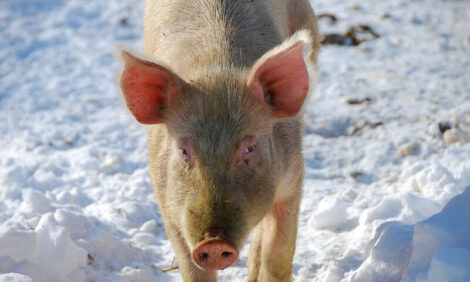



Dry Weather Threatens Previously Optimistic Hogs Outlook
US - Sharp increases in feed prices brought about by the onset of more widespread hot, dry weather have threatened the potential for hog producers to return to profitability, Purdue Extension agricultural economist Chris Hurt says.December corn futures rose to $5 per bushel - a $0.50 increase since the early August lows and soybean meal increased $90 per ton. These equate to about $5 higher hog production costs per live hundredweight. While that doesn't completely dash producers' hopes of returning to profitability, it does mean they need to think twice before growing their operations.
"This has not wiped out profit potential, but should make hog producers more cautious about expansion," Dr Hurt said. "Expected margins have narrowed, but not collapsed."
Hog producers can cover their costs with hog prices above $59 per hundredweight, he said. Current forecasts show fall and winter hog prices at $61 per hundredweight, which should rise to about $65 in the second quarter of 2014 before falling back to $62 for the third-quarter average.
If the forecasts are correct, the average per-hundredweight price over the remainder of 2013 through the third quarter of 2014 would be $62.50 per live hundredweight, which Dr Hurt said would lead to expected average profits of $3.50 per hundred weight, or $10 per head.
"The unexpected recent surge in feed prices might cause some preliminary expansion plans to be aborted and therefore, increases the likelihood that lean hog futures prices also will rise some from current levels that are based on expectations of larger expansion," Dr Hurt said.
At this point, there's no way to know exactly how much corn and soybeans will yield, how much grain and feed prices will increase or how they will affect hog producers. Both crop and livestock producers will know more when the U.S. Department of Agriculture releases its Sept. 12 crop production report, but feed prices won’t be known with any real certainty until harvest is underway.
In addition to the uncertainty in feed prices, hog producers also need to be cautious about expansion because even small growth in the national breeding herd could increase pork supplies enough to send the industry back into losses starting in the fall of 2014, Dr Hurt said.
"Expansion needs to be constrained to no more than a 3 per cent increase in the breeding herd over the next year," he said. "A 2-3 per cent breeding herd expansion would be expected to push the industry back to breakeven."
While a 2 per cent increase in the breeding herd might seem like a relatively small expansion, it means exponential growth in production.
"A 2 per cent increase in the breeding herd means about a 4 per cent expansion in hog production," Dr Hurt said.
Other meats, such as poultry and beef, also will play a role in pork profitability because meat producers compete for consumers. However, current forecasts show beef production down 5 per cent, which means pork producers could grab a larger share of meat consumption.
The bottom line, Dr Hurt said, is for hog producers to consider expansion cautiously.
"When all of these factors are brought together, it means that the industry should strive for a modest expansion," he said. "Advice to individual pork producers at this point is to limit expansion to 2 or 3 per cent."








